- Details
- Hits: 971
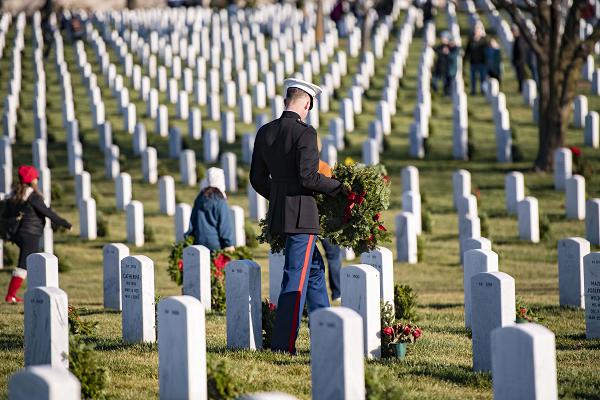
Washington, D.C. (May 23, 2024): Arlington National cemetery is the sacred ground where America buries its war dead, and it has a colorful history unknown to most Americans. In this photo by Elizabeth Fraser, some fifteen hundred servicemembers place wreaths on 260,000 graves to honor those that paid the ultimate price for our freedoms. Maintained by the U.S. Army, Arlington is one of two national cemeteries. Established in 1864, Arlington conducts up to 30 funerals a day on the cemeteries’ 639 acres.
The story of how Arlington became a national burial place involves both George Washington and Confederate General Robert E. Lee and is unknown to many Americans. The land was originally owned by George Custis, the son of Martha Washington, who built a mansion on the property to display his large collection of George Washington memorabilia. When he died, his only child Mary Custis married her distant cousin Robert E. Lee in 1831. At the time, Lee was a West Point graduate and the son of a three-term Virginia governor. The Lees inherited the Custis estate including 196 enslaved persons who lived and worked on the plantation.
After Virginia seceded from the Union, the Lees left Arlington for the south, never to return. In their absence, the U.S. Army confiscated the property following a tax dispute. In those days, taxes had to be paid “in person” to the local authorities, something Lee could not do because he was leading the Confederate Army. The Army established a camp and headquarters on the high ground overlooking Washington and constructed forts on the property, including Fort Whipple (now Fort Myer) and Fort McPherson.
- Details
- Hits: 1038
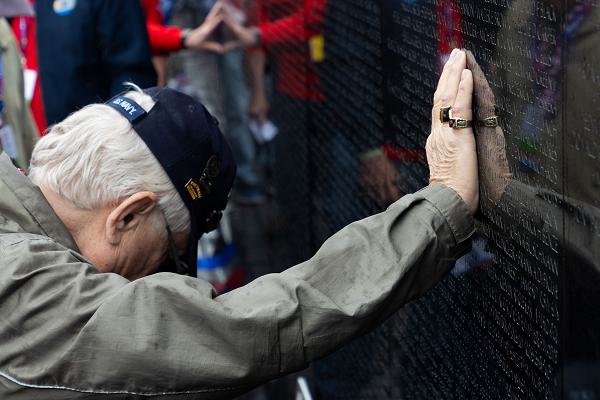
Washington, D.C. (May 24, 2024): As you can see from the photo above, Memorial Day is felt most strongly by veterans who lost comrades in combat. In this photo by Navy Petty Officer 1st Class Ramon Go, a Vietnam War veteran places his hand on “The Moving Wall” at the Vietnam Veterans Memorial during Honor Flight San Diego’s “Tour of Honor.” A small group of former Navy SEALs and members of Naval Special Warfare’s active force volunteered to escort ninety Vietnam War veterans on a three-day trip to Washington to visit the memorials honoring their sacrifice.
Originally known as Decoration Day, today’s Memorial Day originated in the years following the Civil War and became an official federal holiday in 1971. Interestingly, the earliest celebrations of Memorial Day were organized by formerly enslaved people in Charleston, South Carolina right after the Confederacy surrendered. On the first Decoration Day, General James Garfield made a speech at Arlington National Cemetery and 5,000 participants decorated the graves of the 20,000 Civil War soldiers buried there. After World War I, President Woodrow Wilson declared the holiday would recognize those who paid the ultimate price in all U.S. wars.
- Details
- Hits: 1152
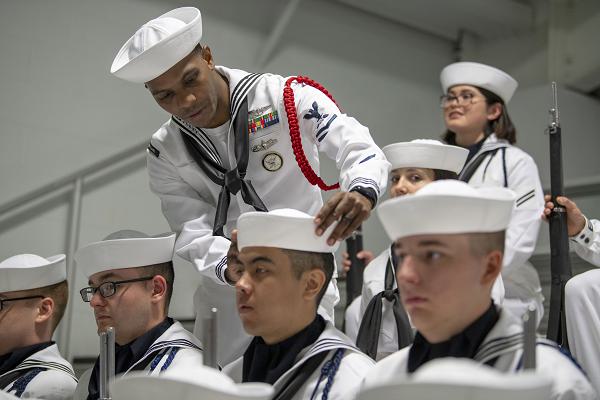
Naval Air Station Great Lakes, Illinois. (May 9, 2024): America’s armed forces are struggling to attract new recruits, and the Navy is determined to do something about it. In this photo by MC2 Christopher M. O'Grady, Aviation Boatswain's Mate (Handling) 2nd Class Lauret Price fixes a recruit's head cover during a recent Recruit Training Command pass in review graduation ceremony. Great Lakes, located near Chicago, is the Navy’s only boot camp that trains more than 40,000 recruits a year.
According to Navy officials’ testimony to Congress this week, the service projects it will miss its recruiting goals by 6,700 recruits this year. Overall, the Navy has achieved seventy percent of its recruiting goals for the first half of this year, lagging the other services who are on target to meet ninety percent of their objectives. The lone bright spot is the Marines who reliably meet their quota regardless of economic conditions.
Currently, the Navy is short 18,000 Sailors needed for operations at sea and an additional 4,000 to do shore-based jobs. Overall, the military services collectively missed their recruiting goals by about 41,000 recruits in 2023.
The Navy has responded aggressively by opening a path for non-high school graduates with demonstrable skills to enlist for the first time. By opening this new path to enlistment, the Navy hopes to expand the pool of applicants while maintaining recruit quality. The Navy announced in January that those without a high school diploma or General Educational Development credential could enlist — if they score a fifty or higher on the Armed Forces Qualification Test. The service projects the change could bring in 2,000 more sailors annually.
The Navy also increased the maximum enlistment age from 39 to 41 and raised the maximum enlistment bonus to $50,000. Additionally, those entering the nuclear field could receive a $75,000 maximum enlistment bonus as of last summer. Navy officials also intend to launch a “Conversation with America” via a series of educational events touting service life and the benefits of sea duty for young people.
- Details
- Hits: 1015
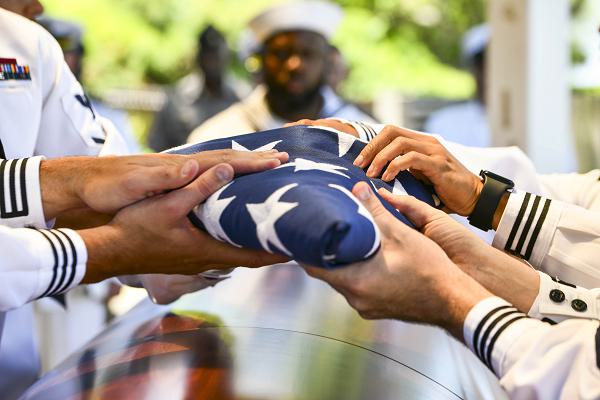
Honolulu, Hawaii. (May 19, 2024): Staying faithful to the American military’s credo of “leave no one behind”, the Defense POW/MIA Accounting Agency (DPAA) and other attendees recently honored the life of Navy Petty Officer 1st Class Robert L. Corn, who was assigned to the USS Oklahoma when it was attacked by Japanese aircraft during World War II. In this photo by Air Force Staff Sergeant Jonathan McElderry, Sailors fold an American flag during his internment ceremony held at the National Memorial Cemetery of the Pacific in Honolulu.
The DPAA’s mission is to recover unaccounted Department of Defense personnel listed as prisoners of war or missing in action from past conflicts anywhere in the world.
Although his remains were recovered from the ship, they could not be identified due to the limitations of science at the time. His remains were buried as “unknown” until advances in forensic techniques prompted the DPAA to reexamine the unknown remains associated with the Oklahoma and Seaman Corn's were eventually identified from among them.
Corn enlisted in the Navy in Portland, Oregon in 1936 and was assigned to the USS Oklahoma the following year. He was one of 429 crewmembers who were killed when a Japanese aircraft dropped a torpedo that struck the ship’s hull flipping her upside down. Survivors jumped off the ship into burning hot water as the ship quickly capsized and sank.
- Details
- Hits: 2401
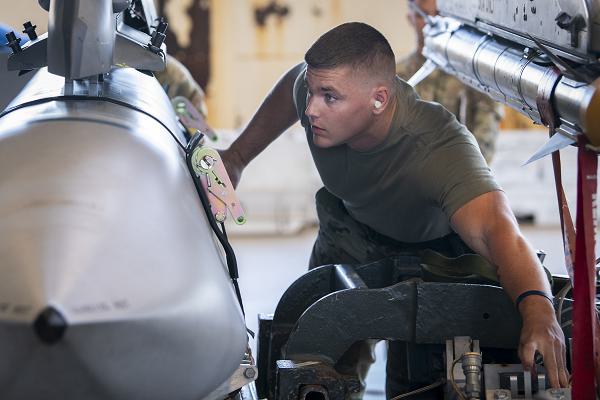
Eglin Air Force Base, Florida. (April 12, 2024): How does the U.S. military turn “dumb bombs” into highly accurate precision guided munitions that can are effective in all weather conditions? In this photo by Samuel King, Jr., Staff Sergeant Jacob Leasum, 96th Aircraft Maintenance Squadron Blue, guides a GBU-31 “smart” bomb into place during a weapons load crew competition. The GBU-31, also known as the Joint Direct Attack Munition (JDAM), is a guidance kit that converts gravity bombs into guided missiles that are not affected by environmental conditions.
The U.S. discovered a major flaw in its air-to-ground warfare strategy during Desert Storm when supposedly precision guided weapons were ineffective due to rain, clouds, fog, dust, or smoke. The infrared “seekers” used on American bombs were obscured by desert dust and smoke and therefore could not “see” their targets.
To counter this, the U.S. military commissioned Boeing to develop the first ever integrated inertial guidance system coupled to a Global Positioning System (GPS) receiver. Jointly developed by the Air Force and Navy, hence the "joint" in JDAM, the kits create a munition that is not affected by smoke or weather. The guidance package is bolted onto 500-to-2,000-pound unguided gravity bombs. The kit includes a tail section with aerodynamic control surfaces and a combined inertial guidance system with a GPS unit.
- Details
- Hits: 1566
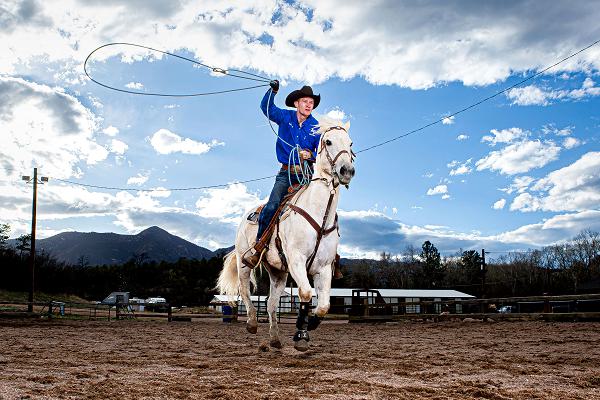
Colorado Springs, Colorado. (May 18, 2024): That’s right, you can join the military and learn to rodeo. The Air Force Academy operates a rodeo club where cadets learn to ride and rope like the ranch hands of the old west. In this photo by Trevor Cokley, Cadet 1st Class Robert Ball, team captain of the Air Force Academy Rodeo Club, rides his horse, Ferg, during practice at the Academy's Equestrian Center. The club participates in five rodeo events each semester that include bull riding, team roping, barrel racing, calf roping, and steer wrestling.
Started by cadets in 2009, the 50-member Rodeo Club competes at the highest level of competition in a state known for its cowboy history. The club meets twice a week to focus on horsemanship and the care and conditioning of their steeds. Cadets manage it all, from grooming to cleaning up after the horses, as they share experiences with their horses. The Air Force believes the rodeo teaches essential skills like thoroughness, teamwork, and leadership.
Today’s cadet cowboys are following a tradition that dates to the 1800s in the old West and the Mexican “vaqueros”, or horse-mounted herders. These men were mostly itinerant ranch hands, constantly on the move working one spread after another with no other belonging than what they could carry on the saddles. They created the rodeo fashions of leather boots, chaps, and big hats along with the roping and riding skills we see in today’s competitions. In fact, the term “rodeo” is derived from Spanish verb “rodear” which means to encircle or round up.


